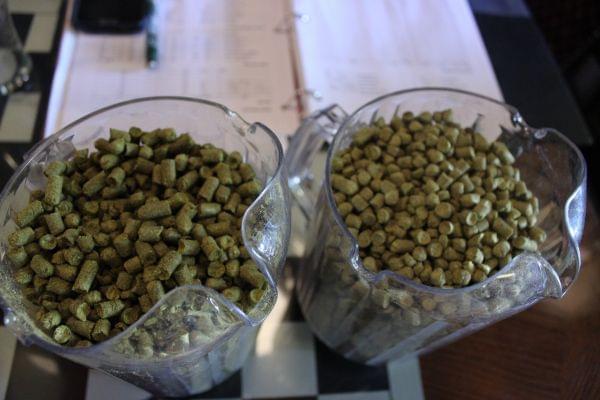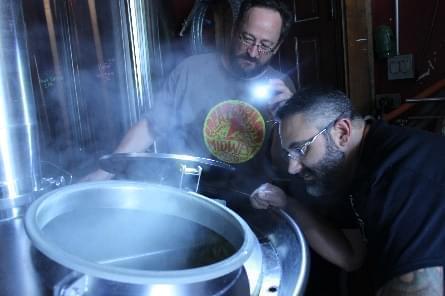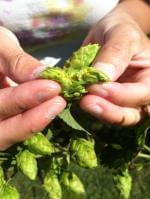The Secret Ingredients Behind Champaign’s Craft Beer Success

Cascade and centennial hops used for one of Bill Morgan's upcoming IPAs. (Photo:Tiffany Jolley)
Central Illinois may seem like an unusual place for a growing craft beer industry, but the Champaign-Urbana area has just the right ingredients - and gets an economic boost because of it.
Illinois Public Media’s Tiffany Jolley talked with some of the brewers and farmers behind Champaign’s local craft beers, and what makes this area unique.
"Craft beer was very much a niche thing, only certain people were into it yet, and a lot of people hadn't heard of it," said Bill Morgan. Morgan brewed his first beer 25 years ago in Champaign, at a time when he says craft beer was largely unheard of.

Blind Pig brewmaster, Bill Morgan and assistant brewer Joshua Martin take a look at what will soon be a white IPA on draft at the Blind Pig brewery in Champaign.
But in recent years, the craft beer industry in Champaign has grown exponentially.
Morgan said, "It wasn't that long ago when there were no craft beer brewers in Champaign, and now there's three local breweries."
According to Morgan, Champaign’s secret ingredient flows from the ground up.
“I think the beer that we make in Champaign has a certain flavor that’s makes it better than craft beer from elsewhere, and I think that’s directly due to the quality of water that we get out of the Mahomet aquifer,” said Morgan.
But he also says that protecting that ingredient is the biggest challenge to the success of craft brewing in Champaign.
.“Every day in the news I’m hearing stories about waste being proposed to be stored somewhere that might leech into the aquifer, and that concerns me greatly,” said Morgan.
Another key ingredient is Champaign's farm to glass approach.
Aaron Young is the head brewer at JT Walker's brewery in Mahomet. Young says the craft beer culture has flourished in Champaign, rivaling even the biggest markets in the county.

Aaron Young and Anna Schweig started the Big Thorn Farm in Georgetown, Illinois four years ago with the goal of growing hops, herbs and fruits to use in craft beer.
"You can go to bigger cities, you can even go to a place known for it like a Denver, and they have a lot of craft beer bars, and I think Champaign is on scale, especially for the size of the town, and if you go to other towns around Illinois and Indiana, it's nothing compared to what Champaign has to offer... it's just taken off!"
Aaron Young and Anna Shweig own Big Thorn Farm in Georgetown, Illinois. They supply breweries like the Blind Pig and JT Walker’s.
Schweig said, “Our whole goal was to have so much stuff, so many things happening, that it would inspire creativity. So we did blackberries, raspberries, rhubarb… all these things that we thought, ‘man if we had pounds and pounds and pounds of these things, we could just make delicious beer!”

Anna Schweig opens a cascade hop cone, exposing the lupulin of the hop. Lupulin is the yellowish powder where the essential oil of the hop is found.
But as the tiny hop plants mature into sustainable adult plants, both Young and Schweig anticipate plenty of growth in Champaign’s craft beer economy in the coming years and Craig Rost agrees. “There’s an expectation that higher quality beverages will be available and people have risen to the occasion and they pay two or three times what they would pay for run-of-the-mill, large production beers, so that craft beers work really well here as part of the economy.”
Rost is the Executive Director of the Champaign County Economic Development Corporation.
The final ingredient in Champaign’s craft beer culture: the people.
“The brewing industry is an open sharing industry and so I go into see Bill at Blind Pig or Anthony at Triptych, and they show me what they’re doing and I go “oh! I gotta get going! This is cool,” said Young, "so for me they’ve taught me a lot of things and it makes me wanna do that stuff too!”
Morgan said the camraderie among breweries is the industry standard.
“That is quite the norm in the craft beer world. We all help each other out when somebody has a piece of equipment breaks down, or they run out of ingredients. We all have each other’s back and make sure that nobody gets in a bit of trouble, so I look forward to what we’ll see in the future.”

